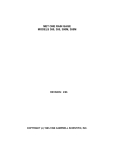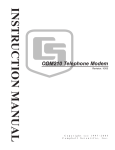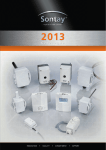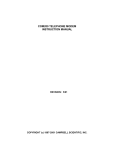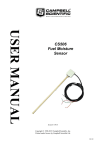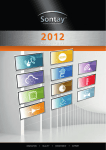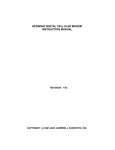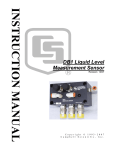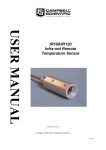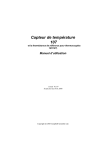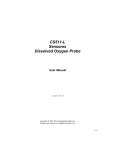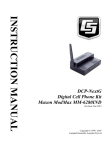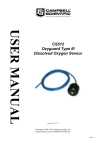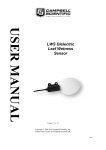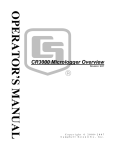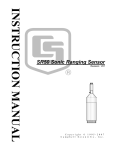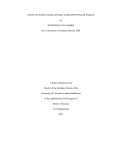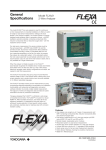Download CS547A Conductivity and Temperature Probe
Transcript
CS547A Conductivity and Temperature Probe and A547 Interface User Manual Issued 16.11.11 Copyright © 1994-2011 Campbell Scientific Inc. Printed under licence by Campbell Scientific Ltd. CSL 421 Guarantee This equipment is guaranteed against defects in materials and workmanship. This guarantee applies for twelve months from date of delivery. We will repair or replace products which prove to be defective during the guarantee period provided they are returned to us prepaid. The guarantee will not apply to: • Equipment which has been modified or altered in any way without the written permission of Campbell Scientific • Batteries • Any product which has been subjected to misuse, neglect, acts of God or damage in transit. Campbell Scientific will return guaranteed equipment by surface carrier prepaid. Campbell Scientific will not reimburse the claimant for costs incurred in removing and/or reinstalling equipment. This guarantee and the Company’s obligation thereunder is in lieu of all other guarantees, expressed or implied, including those of suitability and fitness for a particular purpose. Campbell Scientific is not liable for consequential damage. Please inform us before returning equipment and obtain a Repair Reference Number whether the repair is under guarantee or not. Please state the faults as clearly as possible, and if the product is out of the guarantee period it should be accompanied by a purchase order. Quotations for repairs can be given on request. It is the policy of Campbell Scientific to protect the health of its employees and provide a safe working environment, in support of this policy a “Declaration of Hazardous Material and Decontamination” form will be issued for completion. When returning equipment, the Repair Reference Number must be clearly marked on the outside of the package. Complete the “Declaration of Hazardous Material and Decontamination” form and ensure a completed copy is returned with your goods. Please note your Repair may not be processed if you do not include a copy of this form and Campbell Scientific Ltd reserves the right to return goods at the customers’ expense. Note that goods sent air freight are subject to Customs clearance fees which Campbell Scientific will charge to customers. In many cases, these charges are greater than the cost of the repair. Campbell Scientific Ltd, Campbell Park, 80 Hathern Road, Shepshed, Loughborough, LE12 9GX, UK Tel: +44 (0) 1509 601141 Fax: +44 (0) 1509 601091 Email: [email protected] www.campbellsci.co.uk PLEASE READ FIRST About this manual Please note that this manual was originally produced by Campbell Scientific Inc. primarily for the North American market. Some spellings, weights and measures may reflect this origin. Some useful conversion factors: Area: 1 in2 (square inch) = 645 mm2 Length: 1 in. (inch) = 25.4 mm 1 ft (foot) = 304.8 mm 1 yard = 0.914 m 1 mile = 1.609 km Mass: 1 oz. (ounce) = 28.35 g 1 lb (pound weight) = 0.454 kg Pressure: 1 psi (lb/in2) = 68.95 mb Volume: 1 UK pint = 568.3 ml 1 UK gallon = 4.546 litres 1 US gallon = 3.785 litres In addition, while most of the information in the manual is correct for all countries, certain information is specific to the North American market and so may not be applicable to European users. Differences include the U.S standard external power supply details where some information (for example the AC transformer input voltage) will not be applicable for British/European use. Please note, however, that when a power supply adapter is ordered it will be suitable for use in your country. Reference to some radio transmitters, digital cell phones and aerials may also not be applicable according to your locality. Some brackets, shields and enclosure options, including wiring, are not sold as standard items in the European market; in some cases alternatives are offered. Details of the alternatives will be covered in separate manuals. Part numbers prefixed with a “#” symbol are special order parts for use with non-EU variants or for special installations. Please quote the full part number with the # when ordering. Recycling information At the end of this product’s life it should not be put in commercial or domestic refuse but sent for recycling. Any batteries contained within the product or used during the products life should be removed from the product and also be sent to an appropriate recycling facility. Campbell Scientific Ltd can advise on the recycling of the equipment and in some cases arrange collection and the correct disposal of it, although charges may apply for some items or territories. For further advice or support, please contact Campbell Scientific Ltd, or your local agent. Campbell Scientific Ltd, Campbell Park, 80 Hathern Road, Shepshed, Loughborough, LE12 9GX, UK Tel: +44 (0) 1509 601141 Fax: +44 (0) 1509 601091 Email: [email protected] www.campbellsci.co.uk Contents PDF viewers note: These page numbers refer to the printed version of this document. Use the Adobe Acrobat® bookmarks tab for links to specific sections. 1. Overview....................................................................... 1 1.1 EC Sensor .................................................................................................1 1.2 A547 Interface ..........................................................................................1 2. Specifications .............................................................. 2 2.1 CS547A Probe ..........................................................................................2 2.2 A547 Interface ..........................................................................................2 2.3 Temperature Sensor ..................................................................................3 3. Installation.................................................................... 3 3.1 Site Selection ............................................................................................3 3.2 Mounting ..................................................................................................3 4. Wiring ........................................................................... 3 5. Programming ............................................................... 4 5.1 Programming Overview............................................................................4 5.1.1 Measurement Programming – CRBasic Example Code .................5 5.1.2 Measurement Programming – Edlog Program Example.................7 6. Calibration.................................................................. 11 6.1 6.2 6.3 6.4 Conversion Factors .................................................................................11 Typical Ranges .......................................................................................11 Factory Calibration .................................................................................11 Field Calibration .....................................................................................11 6.4.1 CRBasic Program Example ..........................................................12 6.4.2 Edlog Program Example ...............................................................12 7. Maintenance............................................................... 14 8. Analysis of Errors...................................................... 14 8.1 EC Measurement Error ...........................................................................14 8.2 Temperature Measurement Error............................................................15 9. Deriving a Temperature Compensation Coefficient ................................................................ 16 10. Therm107 / P11 Instruction Details........................ 16 11. Electrically Noisy Environments............................ 18 i 12. Long Lead Lengths Temperature........................... 18 13. CS547A Schematic .................................................. 19 Figures 1-1. A547 Interface and CS547A Conductivity and Temperature Probe .......2 4-1. CS547A Wiring Diagram for Example Below........................................4 8.1-1. Plot of Ideal and Actual Correction between 0 and 0.44 mS cm-1 .....14 8.1-2. Plot of Ideal and Actual Correction between 0.44 and 7.0 mS cm-1 ..15 8.2-1. Error Produced by Polynomial Fit to Published Values.....................16 13-1. CS547A Conductivity and Temperature Circuit Diagram ..................19 13-2. A547 Interface Circuit Diagram..........................................................20 Tables 8.2-1. Thermistor Interchangeability Specification Temperature.................15 8.2-2. Polynomial Error ................................................................................15 10-1. Temperature, Resistance and Datalogger Output................................17 10-2. Polynomial Coefficients ......................................................................17 ii CS547A Conductivity and Temperature Probe and A547 Interface 1. Overview The CS547A conductivity and temperature probe, and A547 interface are designed for measuring the electrical conductivity, dissolved solids, and temperature of fresh water with Campbell Scientific dataloggers. This sensor can be used with any CSI logger that can issue an AC excitation. This includes most new CRBasic dataloggers as well as older, Edlog loggers. Exceptions include the CR200-series, the BDR301 and BDR320 loggers which did not have this feature. Use with our AM16/32(B) multiplexer is possible when needing to measure several of these probes on one datalogger. Electrical conductivity (EC) of a solution is a simple physical property, but measurements can be difficult to interpret. This manual instructs the user how to make EC measurements with the CS547A. Accuracy specifications apply to measurements of EC in water containing KCl, Na2SO4, NaHCO3, and/or NaCl, which are typical calibration compounds, and to EC not yet compensated for temperature effects. Statements made on methods of temperature compensation or estimating dissolved solids are included to introduce common ways of refining and interpreting data, but are not definitive. Authoritative sources to consult include the USGS Water-Supply Paper 1473, The pH and Conductivity Handbook published by OMEGA Engineering, physical chemistry texts, and other sources. 1.1 EC Sensor The EC sensor consists of three stainless steel rings mounted in an epoxy tube as shown in Figure 4-1. Resistance of water in the tube is measured by excitation of the centre electrode with positive and negative voltage. This electrode configuration eliminates the ground looping problems associated with sensors in electrical contact with earth ground. Temperature is measured with a thermistor in a three wire half bridge configuration. 1.2 A547 Interface The interface contains the completion resistors and blocking capacitors. The interface should be kept in a non-condensing environment that is maintained within the temperature range of the unit. 1 CS547A Conductivity and Temperature Probe and A547 Interface Figure 1-1. A547 Interface and CS547A Conductivity and Temperature Probe 2. Specifications 2.1 CS547A Probe Construction The probe housing is epoxy Size — L x W x H 89 mm (3.5 inches) x 25.4 mm (1 inch) x 19 mm (0.75 inch) Maximum Cable Length 305 m (1000 ft). The sensor must be ordered with desired length as cable cannot be added to existing probes. Depth Rating Maximum 305 m (1000 ft) pH Range Solution pH of less than 3.0 or greater than 9.0 may damage the stainless steel housing. Electrodes Passivated 316 SS with DC isolation capacitors. Cell Constant Individually calibrated. The cell constant (Kc) is found on a label near the termination of the cable. Temp. Range of Use 0° to 50°C. EC Range Approx. 0.005 to 7.0 mS cm-1. Accuracy in KCl and Na2SO4, NaHCO3, and NaCl standards at 25°C: ±5% of reading 0.44 to 7.0 mS cm-1. ±10% of reading 0.005 to 0.44 mS cm-1. 2.2 A547 Interface 2 Size Dimensions: 64 mm (2.5”) x 46 mm (1.8”) x 23 mm (0.9”) Weight: 45 g (2 oz) Temperature Rating -15°C to +50°C User Manual 2.3 Temperature Sensor Thermistor Betatherm 100K6A1. Range 0°C to 50°C. Accuracy Error ±0.4°C (See Section 8.2). 3. Installation CAUTION Rapid heating and cooling of the probe, such as leaving it in the sun and then submersing it in a cold stream, may cause irreparable damage. 3.1 Site Selection The EC sensor measures the EC of water inside the hole running through the sensor, so detection of rapid changes in EC requires that the probe be flushed continuously. This is easy to accommodate in a flowing stream by simply orienting the sensor parallel to the direction of flow. In stilling wells and ground wells, however, diffusion rate of ions limits the response time. 3.2 Mounting The housing and sensor cable are made of water impervious, durable materials. Care should be taken, however, to mount the probe where contact with abrasives and moving objects will be avoided. Strain on cables can be minimized by using a split mesh strain relief sleeve on the cable, which is recommended for cables over 100 ft. The strain relief sleeve is available from Campbell Scientific as part number 7421. Because the CS547A has a slightly positive buoyancy, we recommend securing the sensor to a fixed or retractable object or selecting the cable weight option. The A547 is usually mounted in the datalogger enclosure. 4. Wiring WARNING The excitation channel used for each EC measurement must be separate from the one used for temperature or measurement errors will result. If multiple CS547A/A547s are to be wired to a single logger, each conductivity excitation must be kept on a separate, dedicated EX channel, but you can combine several temperature excitations lines onto a single EX port. (On newer loggers, these are labelled as Vx.) 3 CS547A Conductivity and Temperature Probe and A547 Interface AG AG SE TEMP EX2 EX TEMP EX1 EX COND 1H HI COND 1L LO COND Ground DATALOGGER SE3 SHIELD Clear (Shield) SHIELD Red (Temp) TEMP SENSOR COND Orange (Cond) Black (Ex Cond) EX COND Green (Ex Temp) EX TEMP Figure 4-1. CS547A Wiring Diagram for Example Below 5. Programming All example programs may require modification by the user to fit the specific application's wiring and programming needs. All program examples in this manual are for the CR10(X) or CR1000 and assume that datalogger is wired to the A547 interface are as follows: the LO COND lead is connected to 1L, the HI COND to 1H, the EX COND to EX1, the EX TEMP to EX2, and the SE TEMP to SE3. Public Variable Declarations / Input Location Labels Definitions for the following program: Rs Solution resistance Rp Resistance of leads/cable and blocking caps Ct Solution EC with no temp. correction Temp_degC Solution temperature in °C C25mScm_1 EC corrected for temperature 5.1 Programming Overview Typical datalogger programs to measure the CS547A consist of four parts: 1. Measurement of EC and temperature EC: Resistance across the electrodes is computed from the results of the BrFull (P6) or BrHalf (P5) instructions (chosen automatically as part of the autoranging feature) followed by the Bridge Transformation algorithm (P59). 2. Correction of ionization errors in EC measurements Ionization caused by the excitation of the EC sensor can cause large errors. Campbell Scientific has developed a linear correction for conductivity between 0.005 and 0.44 mS cm-1, and a quadratic correction for conductivity between 0.44 and 7.0 mS cm-1. Corrections were determined in standard salt solutions containing KCl, Na2SO4, NaHCO3, and NaCl. 4 User Manual 3. Correction of temperature errors in EC measurements The effect of temperature on the sample solution can cause large errors in the EC measurement. A simple method of correcting for this effect is to assume a linear relationship between temperature and EC. This method generally produces values to within 2% to 3% of a measurement made at 25°C. The best corrections are made when the temperature coefficient is determined at a temperature near field conditions. See Section 9 for details on how to determine the temperature coefficient. If determining the temperature coefficient is not possible, use a value of 2%/°C as a rough estimate. 4. Output processing Over large ranges, EC is not linear and is best reported as samples using instruction P70. In limited ranges, averaging (P71) measurements over time may be acceptable. Convention requires that the temperature at the time of the measurement be reported. 5.1.1 Measurement Programming - CRBasic Example Code 'Program name: CS547A.CR1 '\\\\\\\\\\\\\\\\\\\\\\\\\ DECLARATIONS ///////////////////////// Public Rp, CellConstant, TempCoef Public Rs, Ct Public TempDeg_C Public C25mScm_1 Dim OneOvrRs, Ct100, A, TC_Proces '\\\\\\\\\\\\\\\\\\\\\\\\ OUTPUT SECTION //////////////////////// DataTable (ECSample,True,-1) DataInterval (0,60,Min,10) Sample (1,Ct,FP2) Sample (1,TempDeg_C,FP2) Sample (1,C25mScm_1,FP2) EndTable '\\\\\\\\\\\\\\\\\\\\\\\\\\\ PROGRAM //////////////////////////// BeginProg 'evaluate and edit each of these 3 user specific values Rp=25 'edit this value to the actual footage of cable on your sensor CellConstant=1.50 'edit this value with the Cell Constant (Kc) printed 'on the label of each sensor TempCoef=2 'see section 9 of the manual for an explanation of how 'to more precisely determine the value of this coefficient Scan(5,Sec, 3, 0) 'make a preliminary measurement of resistance to determine best range code BrFull(Rs, 1, mV2500, 1, VX1, 1, 2500, True, True, 0, 250, -0.001, 1) Rs = 1*(Rs/(1.0-Rs)) 'test the initial measurement to then make a more accurate measurement Select Case Rs Case Is < 1.8 BRHalf(Rs, 1, mV2500, 2, VX1, 1, 2500, True, 0, 250, 1, 0) Rs =(Rs/(1-Rs)) 5 CS547A Conductivity and Temperature Probe and A547 Interface Case Is < 9.25 BRFull(Rs, 1, mV2500, 1, VX1, 1, 2500, True, True, 0, 250, -0.001, 1) Rs =(Rs/(1-Rs)) Case Is < 280 BRFull(Rs, 1, mV250, 1, VX1, 1, 2500, True, True, 0, 250, -0.001, 1) Rs = (Rs/(1-Rs)) EndSelect 'Subtract resistance errors (Rp) caused by the blocking capacitors '(0.005Kohm and the cable length(0.000032Kohm/ft) Rp = (Rp* -0.000032)-0.005 Rs = Rs + Rp 'EC is then calculated by multiplying the reciprocal of the resistance, 'which is conductance, by the cell constant OneOvrRs = 1 / Rs Ct = OneOvrRs * CellConstant 'the following corrects for errors of ionization in the EC measurement If (Ct < 0.474) Then Ct = (Ct * 0.9503) - 0.0038 Else Ct=-0.0289+0.9861*Ct+0.0285*Ct^2 EndIf 'correct errors in the EC measurement due to temperature Therm107(TempDeg_C,1,3,Vx2,0,_50Hz,1,0) A = TempDeg_C + -25 Ct100 = Ct * 100 TC_Proces = A * TempCoef TC_Proces = TC_Proces + 100 C25mScm_1 = Ct100 / TC_Proces 'end scan loop by calling output table CallTable ECSample NextScan EndProg 6 User Manual 5.1.2 Measurement Programming - Edlog Dataloggers *Table 1 Program 01: 5 Execution Interval (seconds) ;Make a preliminary measurement of resistance for autoranging. 1: Full Bridge (P6) 1: 1 Reps 2: 15 ±2500 mV Fast Range 3: 1 DIFF Channel 4: 1 Excite all reps w/Exchan 1 5: 2500 mV Excitation 6: 1 Loc [ Rs ] 7: -.001 Mult 8: 1 Offset 2: BR Transform Rf [X/(1-X)] (P59) 1: 1 Reps 2: 1 Loc [ Rs ] 3: 1 Multiplier (Rf) ; ;Test the initial measurement to make a more accurate measurement. ; 3: CASE (P93) 1: 1 Case Loc [ Rs ] 4: If Case Location < F (P83) 1: 1.8 F 2: 30 Then Do 5: AC Half Bridge (P5) 1: 1 Reps 2: 15 ±2500 mV Fast Range 3: 2 SE Channel 4: 1 Excite all reps w/Exchan 1 5: 2500 mV Excitation 6: 1 Loc [ Rs ] 7: 1.0 Mult 8: 0.0 Offset 6: BR Transform Rf[X/(1-X)] (P59) 1: 1 Reps 2: 1 Loc [ Rs ] 3: 1 Multiplier (Rf) 7: End (P95) 8: If Case Location < F (P83) 1: 9.25 F 2: 30 Then Do 9: Full Bridge (P6) 1: 1 2: 15 3: 1 4: 1 5: 2500 Reps ±2500 mV Fast Range DIFF Channel Excite all reps w/Exchan 1 mV Excitation 7 CS547A Conductivity and Temperature Probe and A547 Interface 6: 7: 8: 1 -.001 1 Loc [ Rs Mult Offset ] 10: BR Transform Rf[X/(1-X)] (P59) 1: 1 Reps 2: 1 Loc [ Rs ] 3: 1 Multiplier (Rf) 11: End (P95) 12: If Case Location < F (P83) 1:280 F 2:30 Then Do 13: Full Bridge (P6) 1: 1 Reps 2: 14 ±250 mV Fast Range 3: 1 DIFF Channel 4: 1 Excite all reps w/Exchan 1 5: 2500 mV Excitation 6: 1 Loc [ Rs ] 7: -.001 Mult 8: 1 Offset 14: BR Transform Rf[X/(1-X)] (P59) 1: 1 Reps 2: 1 Loc [ Rs ] 3: 1 Multiplier (Rf) 15: End (P95) 16: End (P95) ; ;Subtract resistance errors (Rp) caused by the blocking capacitors ;(0.005Kohm) and the cable length (0.000032kohm/ft). Enter cable lead ;length in nnn below. ; 17: Z=F (P30) 1: nnn 2: 00 3: 5 F Exponent of 10 Z Loc [ Rp ] 18: Z=X*F (P37) 1: 5 X Loc [ Rp 2: .00032 F 3: 5 Z Loc [ Rp 19: Z=X*F (P37) 1: 5 X Loc [ Rp 2: -.1 F 3: 5 Z Loc [ Rp 20: Z=X+F (P34) 1: 5 X Loc [ Rp 2: -.005 F 3: 5 Z Loc [ Rp 8 ] ] ] ] ] ] Enter cable length in feet. User Manual 21: Z=X+Y (P33) 1: 1 X Loc [ Rs 2: 5 Y Loc [ Rp 3: 1 Z Loc [ Rs ] ] ] ;EC is then calculated by multiplying the reciprocal of resistance, ;which is conductance, by the cell constant. NOTE: The cell constant (Kc) is printed on the label of each sensor or it can be calculated (see Section 6.4). It is entered in place of nnn below. 22: Z=1/X (P42) 1: 1 2: 2 X Loc [ Rs ] Z Loc [ one_ovrRs ] 23: Z=X*F (P37) 1: 2 X Loc [ one_ovrRs ] 2: nnn F 3: 3 Z Loc [ Ct ] Enter cell constant. 24: Temp (107) (P11) 1: 1 Reps 2: 3 SE Channel 3: 2 Excite all reps w/E2 4: 4 Loc [ Temp_degC ] 5: 1.0 Mult 6: 0.0 Offset ; ;The following program set corrects for errors of ionization in the EC ;measurement. ; 25: IF (X<=>F) (P89) 1: 3 X Loc [ Ct 2: 4 < 3: .474 F 4: 30 Then Do 26: Z=X*F (P37) 1: 3 X Loc [ Ct 2: .95031 3: 3 Z Loc [ Ct 27: Z=X+F (P34) 1: 3 X Loc [ Ct 2: -.00378 3: 3 Z Loc [ Ct ] ] F ] ] F ] 28: Else (P94) 29: Polynomial (P55) 1: 1 Reps 2: 3 X Loc [ Ct ] 3: 3 F(X) Loc [ Ct ] 4: -.02889 C0 5: .98614 C1 6: .02846 C2 9 CS547A Conductivity and Temperature Probe and A547 Interface 7: 8: 9: .000000 .000000 .000000 C3 C4 C5 30: End (P95) ;This next program set will correct errors in the EC measurement resulting ;from temperature differences. ; 31: Z=X+F (P34) 1: 4 X Loc [ Temp_degC ] 2: -25 F 3: 6 Z Loc [ A ] 32: Z=X*F (P37) 1: 3 X Loc [ Ct ] 2: 100 F 3: 7 Z Loc [ Ct100 ] 33: Z=X*F (P37) 1: 6 X Loc [ A 2: nnn F 3: 8Z Loc [ TC_Proces ] ] Enter TC (%/°C) to correct cond. reading. 34: Z=X+F (P34) 1: 8 X Loc [ TC_Proces ] 2: 100 F 3: 8 Z Loc [ TC_Proces ] 35: Z=X/Y (P38) 1: 7 X Loc [ Ct100 ] 2: 8 Y Loc [ TC_Proces ] 3: 9 Z Loc [ C25mScm_l ] EC corrected for temperature. ;Output processing, convention states that the temperature be reported ;with the EC measurement. ; 36: Do (P86) 1: 10 Set Output Flag High (Flag 0) 37: Sample (P70) 1: 1 Reps 2: 3 Loc [ Ct ] 38: Sample (P70) 1: 1 Reps 2: 4 Loc [ Temp_degC ] 39: Sample (P70) 1: 1 Reps 2: 9 Loc [ C25mScm_l ] *Table 2 Program 02: 0.0 Execution Interval (seconds) *Table 3 Subroutines End Program 10 User Manual 6. Calibration 6.1 Conversion Factors 1 S (Siemens) = 1 mho = 1/ohm Although mS·cm-1 and µS·cm-1 are the commonly used units of EC, the SI base unit is S·m-1. The result of the example programs is mS·cm-1 EC measurements can be used to estimate dissolved solids. For high accuracy, calibration to the specific stream is required. However, for rough estimates, values between 550 and 750 mg·l-1 / mS·cm-1 are typical with the higher values generally being associated with waters high in sulphate concentration (USGS Water-Supply Paper #1473, p. 99). A common practice is to multiply the EC in mS·cm-1 by 500 to produce ppm or mg·l-1. 6.2 Typical Ranges Single distilled water will have an EC of at least 0.001 mS·cm-1. ECs of melted snow usually range from 0.002 to 0.042 mS·cm-1. ECs of stream water usually range from 0.05 to 50.0 mS·cm-1, the higher value being close to the EC of sea water (USGS Water-Supply Paper 1473, p. 102). 6.3 Factory Calibration The CS547A is shipped with a cell constant calibrated in a 0.01 molal KCl solution at 25.0°C ±0.05°C. The solution has an EC of 1.408 mS cm-1. 6.4 Field Calibration The cell constant is a dimensional number expressed in units of cm-1. The unit cm-1 is slightly easier to understand when expressed as cm·cm-2. Because it is dimensional, the cell constant as determined at any one standard, will change only if the physical dimensions inside the CS547A probe change. Error due to thermal expansion and contraction is negligible. Corrosion and abrasion, however, have the potential of causing significant errors. A field calibration of the CS547A cell constant can be accomplished as follows: 1. Make a 0.01 molal KCL solution by dissolving 0.7456 g of reagent grade KCl in 1000 g of distilled water, or purchase a calibration solution. 2. Clean the probe thoroughly with the black nylon brush shipped with the CS547A and a small amount of soapy water. Rinse thoroughly with distilled water, dry thoroughly, and place in the KCl solution. 3. Connect the CS547A and A547 or probe and interface to the datalogger using the wiring described in Section 4. Enter the following program into the datalogger. The calibration solution temperature must be between 1°C and 35°C; the polynomial in step 11 (P58) corrects for temperature errors within this range. The solution constant of 1.408 mS cm-1 (for prepared solution mentioned above), entered in step 13 (P37), is valid only for a 0.01 molal KCl solution. Location 8 [Kc (cm-1)], generated by step 14, will contain the resultant cell constant. 11 CS547A Conductivity and Temperature Probe and A547 Interface 6.4.1 CRBasic Program Example 'CR1000 Datalogger 'Field Calibration program to determine new Cell Constant (Kc) for CS547A conductivity probe Public Rs, Rp, T Dim T_25, f_of_T Public Conductivity, Kc Const CalSolution = 1.408 'for 0.01 molal KCL solution 'Data Table not required for Field Calibration – monitor “Kc” in Public table 'Main Program BeginProg 'edit cable length (Rp) to reflect footage of actual lead length Rp = 25 'feet Scan (10,Sec,0,0) BrHalf(Rs, 1, mV2500, 2, VX1, 1, 2500, True, 0, 250, 1, 0) Rs =(Rs/(1-Rs)) 'correct for resistance of cabling Rs = Rs + (((Rp*.00032)* -0.1) - 0.005) 'compensate for temperature effects Therm107 (T,1,3,Vx2,0,_50Hz,1.0,0) T_25 = (T-25) * 0.01 f_of_T = 0.99124 - (1.8817*T_25) + (3.4789*T_25^2) - (3.51*T_25^3) - (1.2*T_25^4) - (43*T_25^5) Conductivity = (1/f_of_T)*CalSolution Kc = Conductivity * Rs NextScan EndProg 6.4.2 Edlog Program Example 1: AC Half Bridge (P5) 1: 1 Rep 2: 15 2500 mV fast Range (5000 mV fast for 21X) 3: 2 IN Chan 4: 1 Excite all reps w/EXchan 1 5: 2500 mV Excitation (5000 mV for 21X) 6: 1 Loc [Rs ] 7: 1 Mult 8: 0 Offset 2: BR Transform Rf[X/(1-X)] (P59) 1: 1 Rep 2: 1 Loc [Rs ] 3: 1 Multiplier (Rf) 12 3: Z=F (P30) 1: nnn 2: 00 3: 5 F Exponent of 10 Loc [Rp ] 4: Z=X*F (P37) 1: 5 2: .00032 3: 5 Loc [Rp F Loc [Rp ] 5: Z=X*F (P37) 1: 5 2: -.1 3: 5 Loc [Rp F Loc [Rp ] ] ] Enter Cable Length in Feet User Manual 6: Z=X+F (P34) 1: 5 2: -.005 3: 5 7: Z=X+Y (P33) 1: 1 2: 5 3: 1 Loc [Rp ] Loc [Rp ] X Loc [Rs Y Loc [Rp Z Loc [Rs ] ] ] 8: Temp 107 Probe (P11) 1: 1 Rep 2: 3 IN Chan 3: 2 Excite all reps w/EXchan 2 4: 2 Loc [t ] 5: 1 Mult 6: 0 Offset 9: Z=X+F (P34) 1: 2 2: -25 3: 3 X Loc [t ] F Z Loc [T25_01] 10: Z=X*F (P37) 1: 3 X Loc [T25_01] 2: .01 F 3: 3 Z Loc [T25_01] 11: Polynomial (P55) 1: 1 Rep 2: 3 X Loc [T25_01] 3: 4 F(X) Loc [f_of_T 4: .99124 C0 5: -1.8817 C1 6: 3.4789 C2 7: -3.51 C3 8: -1.2 C4 9: -43 C5 12: Z=1/X (P42) 1: 4 2: 6 ] X Loc [f_of_T ] Z Loc [one_ovrfT ] 13: Z=X*F (P37) 1: 6 X Loc [one_ovrfT 2: 1.408 F 3: 7 Z Loc [Conductiv] ] EC of calibration solution 14: Z=X*Y (P36) 1: 7 X Loc [Conductiv] 2: 1 Y Loc [Rs ] 3: 8 Z Loc [Kc ] End 13 CS547A Conductivity and Temperature Probe and A547 Interface 7. Maintenance Routine maintenance includes thoroughly cleaning the orifice of the CS547A probe with the black nylon brush provided and a little soapy water. Rinse thoroughly. 8. Analysis of Errors 8.1 EC Measurement Error 1. Bridge Measurement Error: < 1.0% 2. Calibration Error: bridge measurement: < 0.5% calibration solution: < 1.0% 3. Ionization Error of KCl and Na+ Solutions After Correction: < 2.0%, 0.45 to 7.0 mS cm-1 < 8.0%, 0.005 to 0.45 mS cm-1 Correction of Ionization Errors: Figures 8.1-1 and 8.1-2 show the amount of correction applied by the example program to compensate for ionization effects on the measurements. Also shown is an ideal correction. Factors were derived by measuring the standard solutions described in Section 2.2 with values of 0.0234, 0.07, 0.4471, 07, 1.413, 2.070, 3.920, and 7.0 mS cm-1. Figure 8.1-1. Plot of Ideal and Actual Correction between 0 and 0.44 mS cm-1 14 User Manual Figure 8.1-2. Plot of Ideal and Actual Correction between 0.44 and 7.0 mS cm-1 8.2 Temperature Measurement Error The overall probe accuracy is a combination of the thermistor's interchangeability specification, the precision of the bridge resistors, and the polynomial error. In a "worst case" all errors add to an accuracy of ±0.4°C over the range of -24° to 48°C and ±0.9°C over the range of -38°C to 53°C. The major error component is the interchangeability specification of the thermistor, tabulated in Table 8.2-1. For the range of 0° to 50°C the interchangeability error is predominantly offset and can be determined with a single point calibration. Compensation can then be done with an offset entered in the measurement instruction. The bridge resistors are 0.1% tolerance with a 10 ppm temperature coefficient. Polynomial errors are tabulated in Table 8.2-2 and plotted in Figure 8.2-1. Table 8.2-1. Thermistor Interchangeability Specification Temperature Temperature (°C) Tolerance (±°C) −40 0.40 −30 0.40 −20 0.32 −10 0.25 0 to +50 0.20 Table 8.2-2. Polynomial Error -40 to +56 <±1.0°C -38 to +53 <±0.5°C -24 to +48 <±0.1°C 15 CS547A Conductivity and Temperature Probe and A547 Interface Figure 8.2-1. Error Produced by Polynomial Fit to Published Values 9. Deriving a Temperature Compensation Coefficient 1. Place the CS547A in a sample of the solution to be measured. Bring the sample and the probe to 25°C. 2. Enter the example program from Section 5.2 in the datalogger and record Ct at 25°C from Location 3. This number will be C25 in the formula in Step 4. 3. Bring the solution and the probe to a temperature (t) near the temperature at which field measurements will be made. This temperature will be t (in °C) in the formula. Record Ct at the new temperature from Location 3. This number will be C in the formula in Step 4. 4. Calculate the temperature coefficient (TC) using the following formula. TC = 100∗ ( C − C 25 ) = %/ ° C ( t − 25)∗ C 25 Enter TC in the appropriate location (nnn) as shown in the program segment in Section 5.2 . 10. Therm107 / P11 Instruction Details Understanding the details in this section is not necessary for general operation of the CS547A probe with CSI's dataloggers. The Therm107 instruction (or P11 in Edlog) outputs a precise 2 VAC excitation (4 V with the 21X) and measures the voltage drop due to the sensor resistance. The thermistor resistance changes with temperature. The instruction calculates the ratio of voltage measured to excitation voltage (Vs/Vx) which is related to resistance, as shown below: Vs/Vx = 1000/(Rs+249000+1000) where Rs is the resistance of the thermistor. 16 User Manual See the measurement section of the datalogger manual for more information on bridge measurements. Temperature is calculated using a fifth order polynomial equation correlating Vs/Vx with temperature. The polynomial coefficients are given in Table 10-2. The polynomial input is (Vs/Vx)*800. Resistance and datalogger output at several temperatures are shown in Table 10-1. Table 10-1. Temperature , Resistance, and Datalogger Output 0.00 2.00 4.00 6.00 8.00 10.00 12.00 14.00 16.00 18.00 20.00 22.00 24.00 26.00 28.00 30.00 32.00 34.00 36.00 38.00 40.00 42.00 44.00 46.00 48.00 50.00 52.00 54.00 56.00 58.00 60.00 351017 315288 283558 255337 230210 207807 187803 169924 153923 139588 126729 115179 104796 95449 87026 79428 72567 66365 60752 55668 51058 46873 43071 39613 36465 33598 30983 28595 26413 24419 22593 -0.06 1.96 3.99 6.02 8.04 10.06 12.07 14.06 16.05 18.02 19.99 21.97 23.95 25.94 27.93 29.95 31.97 33.99 36.02 38.05 40.07 42.07 44.05 46.00 47.91 49.77 51.59 53.35 55.05 56.70 58.28 Table 10-2. Polynomial Coefficients COEFFICIENT VALUE C0 C1 C2 C3 C4 C5 -53.4601 9.08067 -8.32569 x 10-01 5.22829 x 10-02 -1.67234 x 10-03 2.21098 x 10-05 17 CS547A Conductivity and Temperature Probe and A547 Interface 11. Electrically Noisy Environments AC power lines can be the source of electrical noise. If the datalogger is in an electronically noisy environment, the 107 temperature measurement should be measured with longer integration periods than 250µSec. For CRBasic loggers, the Therm107 Integration parameter has options for 60 Hz rejection that impose a long 3mSec integration. Sixty and 50 Hz rejection is also available as an option in the Excitation Channel parameter of Instruction 11 for the CR10X, CR510, and CR23X dataloggers. For the CR10, CR21X and CR7, the 107 should be measured with the AC half bridge (Instruction 5). Example 11-1, CR1000 measurement instruction with 60 Hz rejection: Therm107(TempDeg_C,1,3,2,0,_60Hz,1.0,0.0) Example 11-2. Sample CR10(X) Instructions Using AC Half Bridge 1: AC Half Bridge (P5) 1: 1 Rep 2: 22** 7.5 mV 60 Hz rejection Range 3: 3* IN Chan 4: 2* Excite all reps w/EXchan 2 5: 2000** mV Excitation 6: 11* Loc [ Air_Temp ] 7: 800 Mult 8: 0 Offset 2: Polynomial (P55) 1: 1 Rep 2: 11* X Loc [ Air_Temp ] 3: 11* F(X) Loc [ Air_Temp ] 4: -53.46 C0 5: 90.807 C1 6: -83.257 C2 7: 52.283 C3 8: -16.723 C4 9: 2.211 C5 * Proper entries will vary with program and datalogger channel and input location assignments. ** On the 21X and CR7 use the 15 mV input range and 4000 mV excitation. 12. Long Lead Lengths Temperature If the CS547A has lead lengths of more than 300 feet, use the DC Half Bridge instruction (Instruction 4) with a 2 millisecond delay to measure temperature. The delay provides a longer settling time before the measurement is made. Do not use the CS547A with long lead lengths in an electrically noisy environment. For all CRBasic loggers, as well as CR10X, CR510 and CR23X that have 60 and 50 Hz integration options, this forces a 3 mSec settling time, which accommodates long lead lengths. Longer settling times can be entered into the Settling Time parameter Example 12-1. CR1000 measurement instruction with 20 mSec (20000 uSec) delay: Therm107(TempDeg_C,1,3,2,20000,_60Hz,1.0,0.0) 18 User Manual Example 12-2. Sample Program CR10 Using DC Half Bridge with Delay 1: Excite, Delay,Volt(SE) (P4) 1: 1 Rep 2: 2** 7.5 mV slow range 3: 3* IN Chan 4: 2* Excite all reps w/EXchan 2 5: 2 Delay (units .01sec) 6: 2000** mV Excitation 7: 11* Loc [ Temp_C ] 8: .4*** Mult 9: 0 Offset 2: Polynomial (P55) 1: 1 Rep 2: 11* X Loc Temp_C 3: 11* F(X) Loc [ Temp_C ] 4: -53.46 C0 5: 90.807 C1 6: -83.257 C2 7: 52.283 C3 8: -16.723 C4 9: 2.211 C5 * Proper entries will vary with program and datalogger channel and input location assignments. ** On the 21X and CR7 use the 15 mV input range and 4000 mV excitation. *** Use a multiplier of 0.2 with a 21X and CR7. 13. CS547A Schematic Black (Ex Cond) Green (Ex Temp) Red (Temp) Orange (Cond) Figure 13-1. CS547A Conductivity and Temperature Circuit Diagram 19 CS547A Conductivity and Temperature Probe and A547 Interface Datalogger Connections EX COND HI COND LO COND AG Sensor Connections 1K R2 220µFD + 220µFD + 1K 220µFD + 220µFD + EX TEMP EX COND COND R1 SE TEMP TEMP EX TEMP SHIELD SHIELD Figure 13-2. A547 Interface Circuit Diagram 20 CAMPBELL SCIENTIFIC COMPANIES Campbell Scientific, Inc. (CSI) 815 West 1800 North Logan, Utah 84321 UNITED STATES www.campbellsci.com • [email protected] Campbell Scientific Africa Pty. Ltd. (CSAf) PO Box 2450 Somerset West 7129 SOUTH AFRICA www.csafrica.co.za • [email protected] Campbell Scientific Australia Pty. Ltd. (CSA) PO Box 444 Thuringowa Central QLD 4812 AUSTRALIA www.campbellsci.com.au • [email protected] Campbell Scientific do Brazil Ltda. (CSB) Rua Luisa Crapsi Orsi, 15 Butantã CEP: 005543-000 São Paulo SP BRAZIL www.campbellsci.com.br • [email protected] Campbell Scientific Canada Corp. (CSC) 11564 - 149th Street NW Edmonton, Alberta T5M 1W7 CANADA www.campbellsci.ca • [email protected] Campbell Scientific Centro Caribe S.A. (CSCC) 300N Cementerio, Edificio Breller Santo Domingo, Heredia 40305 COSTA RICA www.campbellsci.cc • [email protected] Campbell Scientific Ltd. (CSL) Campbell Park 80 Hathern Road Shepshed, Loughborough LE12 9GX UNITED KINGDOM www.campbellsci.co.uk • [email protected] Campbell Scientific Ltd. (France) 3 Avenue de la Division Leclerc 92160 ANTONY FRANCE www.campbellsci.fr • [email protected] Campbell Scientific Spain, S. L. Avda. Pompeu Fabra 7-9 Local 1 - 08024 BARCELONA SPAIN www.campbellsci.es • [email protected] Campbell Scientific Ltd. (Germany) Fahrenheitstrasse13, D-28359 Bremen GERMANY www.campbellsci.de • [email protected] Please visit www.campbellsci.com to obtain contact information for your local US or International representative.






























